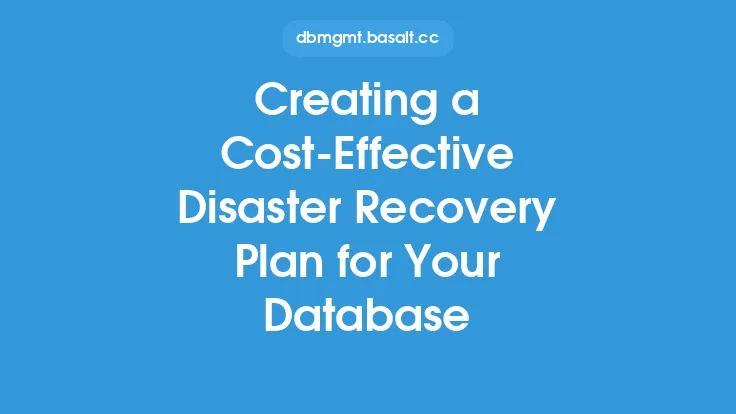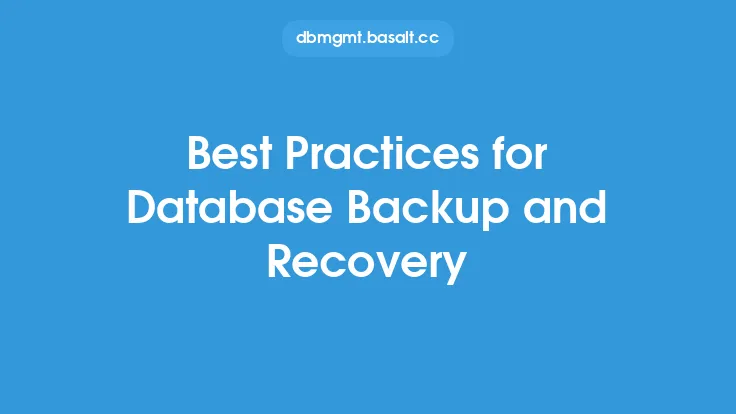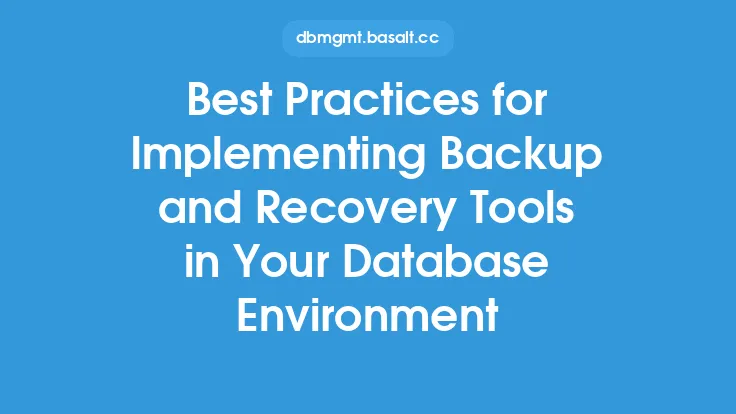Creating a disaster recovery plan is a crucial step in ensuring the continuity and integrity of an organization's database operations. A well-crafted plan can help minimize downtime, reduce data loss, and get the database up and running quickly in the event of a disaster. In this article, we will discuss the best practices for creating a disaster recovery plan that is tailored to the specific needs of an organization's database.
Understanding the Fundamentals of Disaster Recovery Planning
Disaster recovery planning involves identifying the potential risks and threats to an organization's database, assessing the impact of a disaster on the business, and developing strategies to mitigate those risks. It requires a thorough understanding of the database infrastructure, including the hardware, software, and network components. The plan should also take into account the organization's business requirements, such as the need for high availability, data integrity, and security.
Identifying Critical Database Components
To create an effective disaster recovery plan, it is essential to identify the critical components of the database infrastructure. This includes the database servers, storage systems, network devices, and any other components that are essential to the operation of the database. The plan should also consider the dependencies between these components and how they interact with each other. By understanding the critical components and their dependencies, organizations can develop a plan that prioritizes the recovery of the most critical systems and data.
Developing a Risk Assessment and Impact Analysis
A risk assessment and impact analysis are critical components of a disaster recovery plan. This involves identifying the potential risks and threats to the database, assessing the likelihood and impact of each risk, and prioritizing the risks based on their potential impact on the business. The analysis should consider various types of disasters, including natural disasters, hardware failures, software bugs, and cyber-attacks. By understanding the potential risks and their impact, organizations can develop a plan that mitigates those risks and minimizes the impact of a disaster.
Creating a Disaster Recovery Team
A disaster recovery team is essential to the success of a disaster recovery plan. The team should include representatives from various departments, including IT, business operations, and management. The team should be responsible for developing, testing, and implementing the disaster recovery plan. They should also be trained to respond quickly and effectively in the event of a disaster. The team should include individuals with expertise in database administration, network management, and business operations.
Documenting the Disaster Recovery Plan
The disaster recovery plan should be thoroughly documented, including all the procedures, protocols, and contact information. The plan should be easy to understand and follow, even for individuals who are not familiar with the database infrastructure. The documentation should include details on the critical components, risk assessment, and impact analysis, as well as the procedures for recovering the database and restoring operations. The plan should also be regularly reviewed and updated to ensure that it remains relevant and effective.
Testing and Updating the Disaster Recovery Plan
Testing and updating the disaster recovery plan are critical to ensuring its effectiveness. The plan should be tested regularly to ensure that it works as expected and that the team is prepared to respond to a disaster. The testing should include simulations of various types of disasters, including natural disasters, hardware failures, and cyber-attacks. The plan should also be updated regularly to reflect changes in the database infrastructure, business operations, and risk landscape.
Implementing Automation and Orchestration
Automation and orchestration can play a critical role in disaster recovery planning. By automating routine tasks and orchestrating the recovery process, organizations can reduce the risk of human error, minimize downtime, and speed up the recovery process. Automation and orchestration can also help to ensure consistency and repeatability, which are essential for successful disaster recovery.
Ensuring Data Integrity and Security
Data integrity and security are critical components of a disaster recovery plan. The plan should ensure that the data is handled correctly and securely during the recovery process. This includes ensuring that the data is backed up regularly, stored securely, and transmitted securely. The plan should also include procedures for validating the data and ensuring its integrity during the recovery process.
Monitoring and Reporting
Monitoring and reporting are essential to ensuring the effectiveness of a disaster recovery plan. The plan should include procedures for monitoring the database infrastructure, detecting potential issues, and reporting on the status of the recovery process. The monitoring and reporting should be automated as much as possible, with alerts and notifications sent to the disaster recovery team in the event of a disaster.
Training and Awareness
Training and awareness are critical to the success of a disaster recovery plan. The disaster recovery team should be trained regularly on the plan, including the procedures, protocols, and contact information. The team should also be aware of the potential risks and threats to the database and the importance of responding quickly and effectively in the event of a disaster. The training should include simulations of various types of disasters, as well as regular reviews and updates of the plan.
Reviewing and Updating the Plan
The disaster recovery plan should be reviewed and updated regularly to ensure that it remains relevant and effective. The review should include an assessment of the plan's effectiveness, as well as any changes to the database infrastructure, business operations, or risk landscape. The update should include any new procedures, protocols, or contact information, as well as any changes to the risk assessment or impact analysis. The review and update should be done at least annually, or more frequently if there are significant changes to the database infrastructure or business operations.





